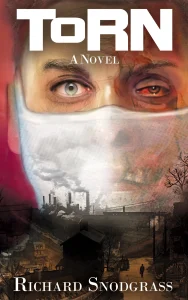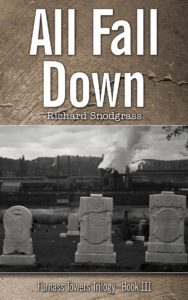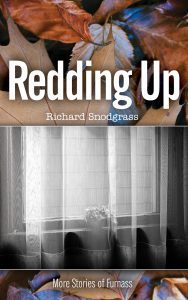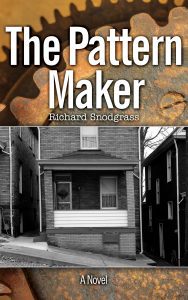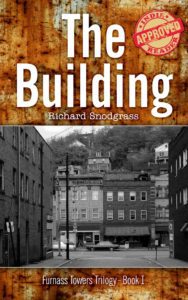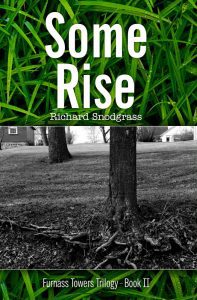There’s been a murder in Furnass—or has there? The death under suspicious circumstances of prominent real estate developer Dickie Sutcliff leads the Reverend Bryce Orr to play detective. Ignoring contradictory evidence as well as prime suspects such as Dickie’s wife or brother, Bryce’s favorite suspect is his childhood friend, Julian Lyle. Meanwhile Lyle, a less than successful lawyer in town whose aspirations included the failed Furnass Towers project, is most concerned with stopping his new best friend Kim Leong from using his martial arts skills to kill a local drug dealer who may have something to do with the disappearance of Kim’s teenage daughter. The threads of these various investigations reach a violent conclusion amid missed connections and misplaced loyalties, as well as the possibilities for forgiveness.
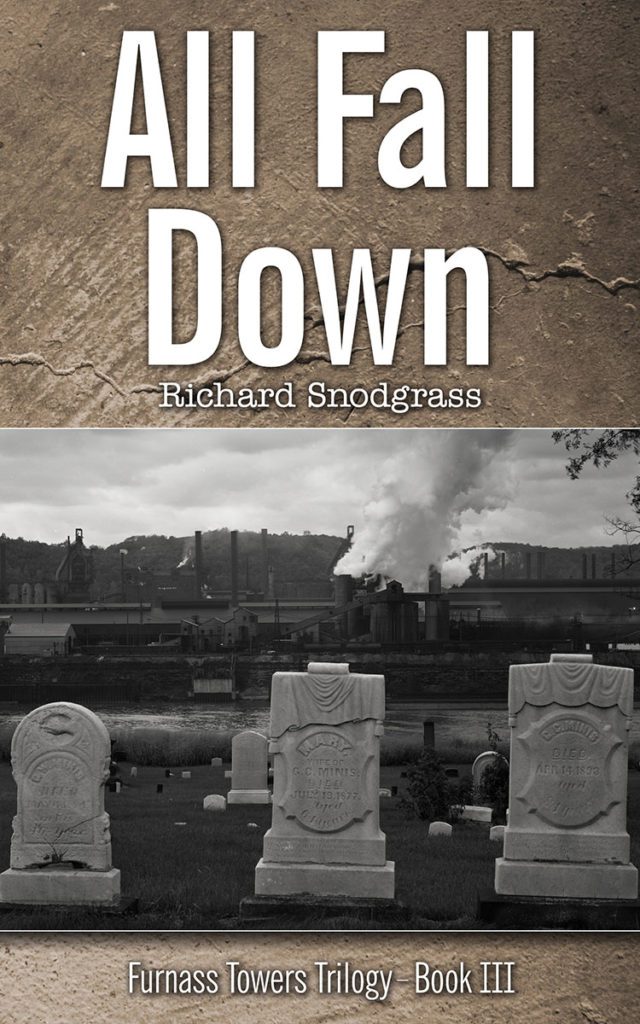
Videos
About Book THREE
Reader’s Guide to ALL FALL DOWN
Summary
When small-town real estate mogul Dickie Sutcliff is found dead one night in his office, nobody really questions the circumstances—his death is considered accidental by everyone except Reverend Bryce Orr, the unconventional minister who presides over the funeral. Spurred into action both by the suspicions of Dickie’s girlfriend and his own curiosity, Bryce turns to the residents of Furnass, Pennsylvania, to uncover the truth. Although readers may be able to guess the identity of the murderer early on, many of the characters, including Bryce, remain in the dark. Reminiscent in this way of several of Agatha Christie’s iconic murder mysteries, All Fall Down quickly becomes both a whodunit and a “whydunit”: Who else in Furnass knew the truth about what happened that night? What possible motive could there have been for this crime? Told through multiple perspectives, the novel allows readers to gradually unearth the answers and discover just how deep some allegiances can run. The third installment in Richard Snodgrass’s Furnass Towers series, All Fall Down is a compelling and complex read that grapples with the intricate concepts of morality, loyalty, and vengeance.
Questions and Topics for Discussion
- How does the information offered in the italic passages set this work apart from other novels in the mystery genre? In what ways does the author maintain the suspense of the story despite disclosing key information at the beginning?
- Do you feel Kim truly acted in self-defense during the violent altercation with his father? How does your opinion relate to your views of acting in self-defense in general, both within this novel and in your own life?
- All Fall Down contains detailed descriptions of architecture and interior design from the perspectives of many characters. What do you feel is the significance of these passages? In what ways do these descriptions contribute to the development of various characters and their experiences in Furnass?
- How does humor, particularly as introduced by Bryce’s character, work with the dramatic nature of the plot? Why do you think the author chose Bryce as the primary comedic outlet in this novel?
- What theories regarding the motive for Dickie’s death did you develop as you read? How did these theories change as more information was revealed?
- While reflecting on past events, Kim thinks to himself, “The world isn’t about thinking; it’s about acting. Doing whatever needs to be done, whenever it needs to be done.” Do any other characters in All Fall Down seem to abide by this mind-set? Do you agree with this statement? Why or why not?
- How does Kim’s relationship with Cory add depth to his character? In what ways has his past influenced this relationship?
- Do you think Julian’s loyalty to Kim is based on fear or genuine respect? Discuss the ways in which this friendship changes as the book progresses.
- How do you think the rivalry between the Sutcliffs and the Lyles affected Julian’s reaction to Dickie’s death? Do you think Julian would have reacted as he did if someone other than Dickie had been murdered?
- Discuss the similarities between Tinker and Julian, especially within the context of their ties both to each other and to Dickie. In what ways do these similarities create problems for the two toward the end of the novel?
Reviews, Extra Scenes, etc.
General Introduction to “Extras”
All Fall Down went through many, many versions and machination over the 35+ years it took to finalize the Furnass Series—even though it was book three of the ten book series and the closing book of the Furnass Towers Trilogy, the series didn’t jell in its entirety until All Fall Down took its final form, which then necessitated going back and synchronizing all the books with its discoveries. Way back when, at its inception with the first book of the series, All Fall Down wasn’t thought of as part of a trilogy at all, it was only a follow-up book to The Building. However, the central action of the book, the death of Dickie Sutcliff, always remained constant; it was the entire developments of the second book, Some Rise, that developed the Trilogy.
Along the way All Fall Down also took on many names: Black Trees; Hunters in the Snow; If I Should Fall in Grace with God, to name a few. And oh, the action of the early versions was glorious, glorious, including a character called The Wiz, Jerzy Wiznicki, a partner with Julian Lyle in Furnass Towers who embezzles and absconds with all the money, leading Bryce to follow him to Stratford Ontario and the winter rehearsals of the Canadian Shakespeare Festival. It was certainly fun to write about Stratford and all, a place very dear to the hearts of Marty and me, but I wisely let the story develop on its own, without my predilections, with the results of the book as it is now.
Among the many milestones in the book’s development, two stand out to me as I write this. The first was an inspiration that came to me years ago, and one that I carried with me on whatever PDA or iPhone happened to be in my pocket. Here’s the note as it appears today in the Notes on my current phone, dated January 13, 2007:
Rachel comes up to him after the service at the cemetery…He goes to stand with her proud of himself…she says You just couldn’t help yourself, could you?…he made some reference to Dickie Sutcliff…some kind of remark about their past or the kind of person he was…then she says not to forget to do something…and he mumbles to himself about why does she do that…as if I didn’t know what I was doing…why does everybody get the pleasant Rachel except me?
Starting the book with that image of Bryce and Rachel standing in that hilltop cemetery on a winter’s day, and the corresponding inversion of the book’s timeline, opened up the story and it began to flow of its own energy.
The second milestone was realizing that Bryce’s childhood friend was named Julian. Lyle had gone through all sorts of names over the decades, in my attempt to have him live on his own and not be a copy or transcription of the several people who originally inspired the character. Over the decades this character had been known variously as Sylvan, Damian, Niblock (with the nickname of Nib), and, of all things, Cricket; for that matter, when the books started out his last name wasn’t Lyle, it was Bates. But Bates was too English in an area settled originally by the Scots and Scots-Irish; plus, the name Lyle, with its Highland roots, also had the evocation of the word “lie” in its pronunciation, which might alert a reader subconsciously that there could be some self-deception working in regard to the character.
The examples that follow will give you some idea of the many machinations the book went through over the years.
Samples of Chapter Outlines 2001
I have always been interested in fugue and counterpoint—“always” isn’t too much of an exaggeration: one of my earliest memories is sitting on the floor in front of the speakers of our Victrola consul trying to pick out the interweaving of the various voice lines in the Bach concertos my sisters played. To translate this structural form into literature, however, means that one must have a helluva memory to keep the voices separate, or not be averse to making notes and charts, lots of charts. Fortunately, I find charts often have an interest all their own.
In 2001, when I was once again tackling the story the was currently called Black Trees and trying to get deeper into the various characters’ motivations, I came across Michael Chekhov’s book, On the Technique of Acting. In Chekhov’s principles, the actor uses physical gestures such as a person’s walk or hand/arm movements to reveal character; for instance, the way that person walks is the key to his/her personality. In order to get to know my own characters better, I tried outlining each chapter before I wrote it to give myself some idea as to the various characters’ telling gestures, immediate and far-reaching motivations, etc. The following samples are from the version that I worked on in 2001. The exercise was helpful, I think, in providing deep background for each character. But fortunately, when it came to actually do the writing, it all got pushed to the rear of my consciousness as the characters themselves determined the story.
Outline/Sketches 2011
The working outline/sketches for version of All Fall Down in 2011. At the time the book was titled Black Trees, then later If I Should Fall in Grace with God. Many of the characters’ names weren’t established at this time—among them Julian and Harry Todd—thus affecting some essential actions of the story, but I’ve changed them to the final form for this reproduction. You’ll also note that at this Harry Todd (Quinton) was an unsuccessful painter of the Bay Area Figurative School and much more of an ex-hippie—a reading imposed upon the poor guy from the author’s own experiences and interests….
Bryce in Church
The Reverend Bryce Orr (he loved to refer to himself as the Right Reverend, but now we’re getting into the freaky realities between an author and his/her characters) interested me over the years, through all the machinations, title changes, character changes that All Fall Down went through. He was undoubtedly one of the driving forces behind wanting to write the novel, the one character who sprang into existence more or less fully formed—the idea of a hippy-dippy minister who was straining against the confines of organized religion (though what denomination is never said), who has his own ideas of Christianity but who nevertheless has to practice the orthodoxy in order to keep his job. A job, incidentally, that allows him the license and freedom to pretty much do what he wants during the day, bopping around to see parishioners or whoever he deems needing his good counsel.
In writing about Bryce, though, I was torn about saying too much. In stating the things that he did believe in, it tended to sound preachy and didactic on the writer’s part; what started out as deep background began to sound too much like a sermon directed at the reader. And who the heck would want to read something like that? But just in case you’re interested in what the actually believes, here is a scene that I cut of Bryce along in the church at night, talking to himself and his imagined parishioners. The quotes are from The Gospel of Thomas, an early Christian non-canonical “sayings” gospel that many scholars believe provides insight into the oral gospel traditions. It was discovered near Nag Hammadi, Egypt, in December 1945 among a group of books known as the Nag Hammadi library.
(If you’re acquainted with my work and all of this has a familiar ring to it, much of what Bryce says harkens back to the character of David Lomanongye in my novel There’s Something in the Back Yard, the worldly elder of the Hopis who has a metaphysical discussion with the hapless George Binns:
“…. but he says something to the effect that, if the body came into being because of the spirit, then that’s a wonder. But if the spirit came into being because of the body, then that’s the wonder of wonder. That has some pretty far-reaching implications, if you think about it, particularly in regard to evolution.”
“There’s another part, where Christ is telling the disciples the things they have to do to save their souls, and he tells them to ‘become passers-by.’ That’s nice, isn’t it? It’s like the Gospel written by Camus. And there’s another part that sounds like the Gospel according to Freud: ‘If you bring out what is inside you, what is inside you will save you; but if you don’t bring out what is inside you, what you don’t bring out will destroy you.’ You should read up on the early church some time; it’s almost as weird as the Hopis.”)
BRYCE TALKING TO HIMSELF IN CHURCH
“Fathers and teachers,” he said out loud to the dark congregation. He had a good voice for sermons, he had to admit, just the right amount of seriousness and tenor. The media is the message. Words of comfort for the troubled at heart. “You ask me what is hell. And I maintain it is the inability to believe in what you’re not only being paid to believe in but also trying to get others to believe in too.” He got up, brushed off the seat of his pants, and went over to the pulpit where he gave his sermons each Sunday. “Okay, good people, try this one on for size: The disciples asked Jesus, ‘What do you want us to do? Do you want us to fast? How should we pray? Should we give to charity? What diet should we observe?’ And Jesus said to them, ‘Don’t lie, and don’t do what you hate.’ How do like them apples? Or here’s another, on the subject of how to find the Kingdom of God: When the disciples asked Jesus, ‘What is the place to which we shall go?’ He replied: ‘The place that you can reach, stand there.’ In other words, wherever you go, there you are. Or what about this one: Jesus said, ‘If you bring forth what is within you, what you have will save you. If you do not have that within you, what you do not have within you will kill you.’ How does that suit you? Or this one, written down from a time when the church wasn’t concerned about keeping all you sheep in line, how to make a church that could keep everybody in their control, but interested in helping each person experience the Lord directly: Jesus said, ‘If the flesh came into being because of spirit, that is a marvel; but if spirit came into being because of the body, that is a marvel of marvels.’ If that doesn’t scare the shit out of you, you’re not comprehending what you’re hearing. But of course I’m not supposed to teach you anything like that. These are teachings that the early church fathers considered heresy because they might start you thinking for yourselves. And you certainly can’t tolerate anything like that, not if your main concern is how to keep everyone in lockstep.”
Was someone there, in the shadows of the back of the church? “Rachel?” He had to cut this out, he was spooking himself.
He left the pulpit and walked down the steps of the sanctuary, through the railing and out into the dark congregation, up the main aisle to where he liked to sit, in the middle of the rows of pews, under the rose window overhead in the dome. So if he no longer believed in the orthodoxy, why did he stay on in the ministry? But he knew the answer to that one too. He had no place else to go. He had no other way to make a living now, he had no marketable skills, every time he made a pastoral visit to a workplace—whether it was to a real estate office or body shop, a clothing store or food market—it reinforced how unprepared he was to do any other line of work, and he was too old now to be hired to learn a new one. More than that, though, he literally had no place else to go: he and Rachel had never owned a home of their own, they were always dependent on the houses provided by the congregations he ministered to, and with his salary and two children to put through college they had never been able to save anything, he had to stay around now to get his pension or they would be homeless and destitute.
You got me by the short hairs, Lord, though I guess at this stage of the game it’s hard to say whether I’m stuck with you or you’re stuck with me. And yet I do love this place, this building, I do.
Version 2
I believe in you but not your church. How can I take a holy organization seriously that started out as a storefront operation in Jerusalem run by your family? It could have gone any direction in those first centuries, and they almost had it too, it was right there in front of them, in all those gnostic texts they later banned because the church fathers were afraid, they were afraid if they went that direction they’d end up with a church full of people who would be impossible to govern. Because how are you going to govern people who run around believing “Blessed are the solitary and the chosen, for you will find the Kingdom, for you are from it, and to it you will return.’ So it all went to hell, the church fell into the hands of bureaucrats and power brokers and people who had to institutionalize faith so they could have power over other people. A church became a system for one small group of people to maintain control over a larger group of people so the system and the institution could maintain itself. I know all that, and yet I do love this place, this building, I do.
Rose or Catherine Windows
The following is an entry from Wikipedia on the subject of Rose Windows or Catherine Windows that I consulted as background, among others, in writing All Fall Down.
Fact is, among the many early versions of the book under a variety of titles, there wasn’t a tower window in the book, or a tower for that matter. The church was vaguely patterned after one where a high school friend of mine ended up as pastor. He and I reconnected when we found ourselves living in the same community near Pittsburgh in the early 1980s, and we often hung out bopping around the empty church. A feature of the church was a large concave stained-glass wheel window in a dome high above the congregation. After years of being exposed to the smoke and grit of the mills around Pittsburgh, the window when my friend first took over the pastorship appeared almost blank from the floor of the church, murky gray with just a hint of vague color here and there. One day poking around the rafters of the church my friend discovered not only the top of the window in its framework, but that he could restore the color of the glass to its original luster with a toothbrush and some vinegar water. Over the next year he spent every free moment working on the window, lying spreadeagle to distribute his weight over the sagging and creaking leading, meticulously restoring it.
The story of the guy risking life and limb stretched out over that window working to restore it seemed too good to be true. And it turned out to be just that. The problem was that it was too obvious that somebody somehow was going to go through that window. Maybe it was also that I was trying too hard to incorporate that image/symbol/metaphor/whatever into the book. Finally, after years of trying, it occurred to me to make that element of the story a wheel window in the tower of the church. Yes, I had to remake the descriptions of the church to include a tower, but once I made that change the story and the action took off on its own accord. As for the symbology of the window, I suspect there is some but whenever it nipped around the edges of my consciousness I scolded it and sent it back to its corner. Though I admit, the idea of the Catherine Window, the evocation of Catherine on the wheel—the struggle and pain an individual has to go through to get to the other side— still called to me from its dark corner at times so I knew it was still around….
